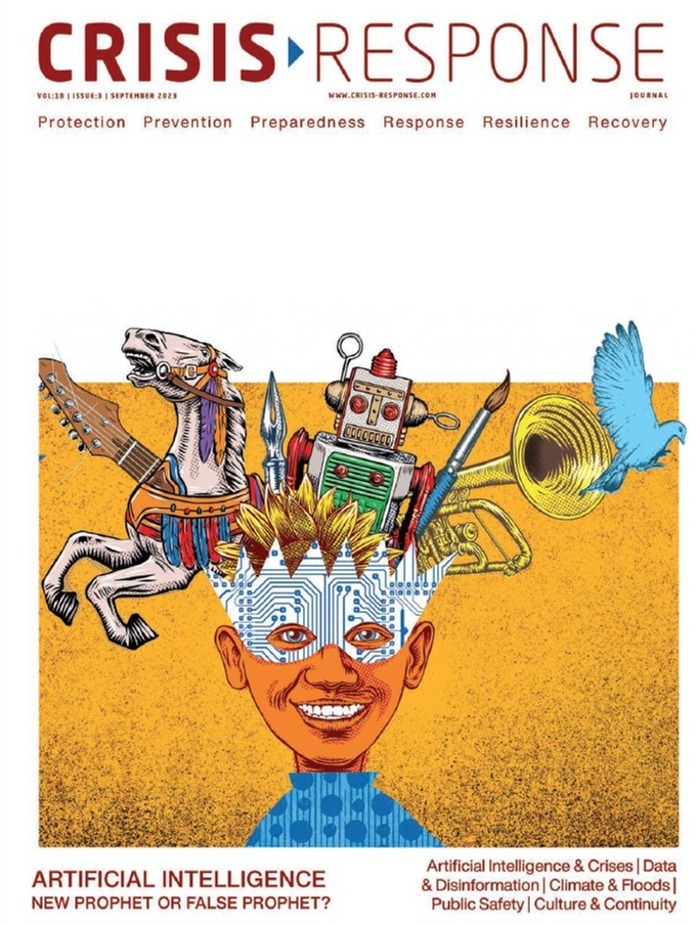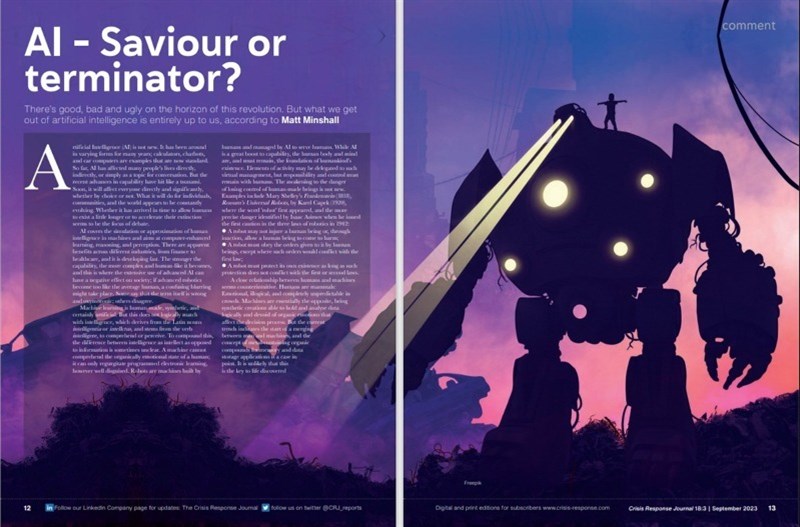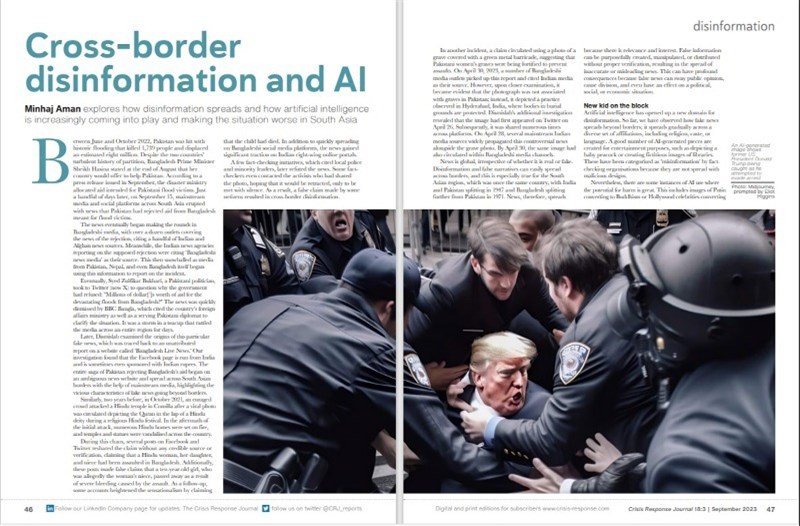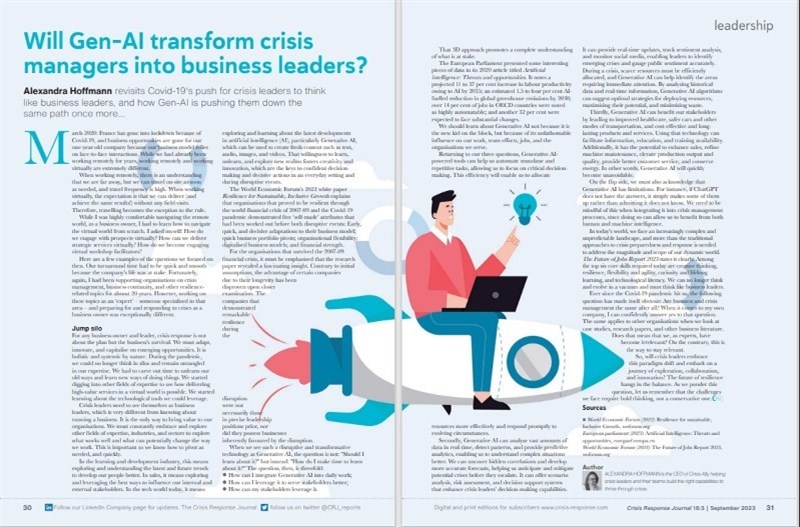CRJ 18:3 is out now!
 The September edition of the CRJ is now live. Hard copies are being mailed out and all subscribers can log in and read the digital edition through the CRJ website.
The September edition of the CRJ is now live. Hard copies are being mailed out and all subscribers can log in and read the digital edition through the CRJ website.
In this edition, we examine artificial intelligence (AI) as our main feature, delving into the contexts of crises, including data and disinformation, resilience, public safety, and leadership. Will it become a new way of life or will it have a serious consequence to life as we know it?
We also revisit May’s flooding in Italy, and look at the unfolding situation in several South Asian countries. The edition also takes a look at the changing nature of crisis management in a world where business culture and continuity are fast evolving.
Andy Marshall and John Hetherington tag team to discuss the challenges of ‘in-betweener,’ incidents. This would be an incident that doesn’t quite grow big enough for it to be identified as a crisis, but: “Yet is still complex, involves multiple stakeholders and needs cross-functional leadership,” they write.
This edition also includes a review on CRJ’s Advisory Panel Member, David Rubens' book Modelling and managing complex risks. One more must-read is Robert Hall’s Building Resilient Futures, where he offers a wider interpretation of resilience, one which requires a shift in thinking away from risk.
This issue puts forward some insightful debates on what AI means for our future. “The idea that AI enhances human learning is true only for those who wish to learn; for the rest, it is an excuse not to learn at all,” writes Matt Minshall.
Meanwhile, Lina Kolesnikova and Michael Kolatchev try to balance the pros and cons: “AI is not the first technology that humans have developed, nor is it the first one that we have apprehensions about. Let us hope humanity will find a way to address the pitfalls of AI while retaining its positives.”
Christine Jessup offers a much-needed discussion on how allowing consumerism and capitalism to guide AI growth is the problem. Could it become Frankenstein’s monster? With the right safety measures, possibly not.
Ilan Kelman discusses whether AI has a place in crisis response. If anything, he asserts that it’s been around for a while: “AI should not be entirely avoided. After all, it has long been an integral part of crisis response… AI could guide firefighters through a burning building in real-time by predicting the fire’s evolution or prioritise collapsed building searches after an earthquake. Provided that the programming is good enough.”
 Andrew Staniforth discusses AI in the world of disinformation
Andrew Staniforth discusses AI in the world of disinformation
Onto leadership: Alexandra Hoffmann notes that Gen-AI is going to push crisis leaders to change how they operate. Mostafa Sayyidi and Michael J Provitera explore the importance of disruptive authentic leadership, using Martin Luther King’s legacy as an example.
Ask what it can do for you: AI has been rapidly developing with the expectation that it may solve many Problems. Yet, there are domains where AI hasn't found a home. Dr Shiva Sivasubramaniam examines its role in the academic sector where it may play a Dr Jekyll and Mr Hyde role there.
Ekaterina Kostioukhina explores the potential of AI in the medical sector in the realm of crisis management and leadership. The healthcare sector faces a great challenge with a scarcity of medical professionals and the urgent need for efficient healthcare delivery. AI can be a solution, she suggests.
This edition has several pieces exploring public safety. Amy Leete examines whether upcoming developments in the artificial intelligence domain will make emergency response faster and more effective.

Matt Minshall discusses the good, bad and ugly of AI
Charles Werner looks at public safety and AI-powered drones. There’s a world of opportunity here, and he takes us through some of the problems such tech can solve by providing data analysis and strategic recommendations in various emergency scenarios.
Can we augment the way we train people on the frontlines? Evie Lunn takes a look at how virtual reality can help to train humanitarian aid workers.
On the non-AI public safety front, Amy Leete investigates how a security update led to millions of false calls to emergency numbers around the world. What kind of burden does such a huge problem put on already struggling services?
One of the most important pieces that this edition includes comes from Jeannie Barr. She takes a look at the cost-of-living crisis in the UK and how it has directly contributed to the dwindling numbers of volunteers in the country.
Examining the intersection of artificial intelligence and data and disinformation are several pieces. Minhaj Aman reports on how disinformation spreads and how AI is increasingly coming into play to worsen the issue in South Asia.
In the same vein, Andrew Staniforth writes: “The use of AI tools to tackle disinformation is developing the approach of news media organisations, but only to an extent. Existing AI-based solutions often only target a specific application – for instance, disinformation on a specific topic such as the Covid-19 pandemic or a specific information channel – and their accuracy in generalising beyond training is barely verifiable, if at all.”
Araba Cole looks at the link between AI, data and crisis management. “The potential for AI is enormous and discussions around the threats AI may pose are warranted, for now, we can look forward to working with AI tools in the same way humans have always worked with new technologies: To further our goals and explore new possibilities,” she writes.
Shefalika Maini has covered AI, data and misinformation from two different perspectives in her articles. She ventures into the landscape of AI and digital surveillance technologies (DST), unmasking their virtues, vices, and unsettling repercussions on the bedrock of our fundamental human rights.

Minhaj Aman's report on AI and disinformation brings into focus 'fake' images of Trumps' arrest
Her other piece examines the role of AI in democratic processes. As AI-powered disinformation manipulates elections and polarises societies, she stops to ask: Can we safeguard our electoral processes?
On to hazards: Roger Gomm dissects the new National Risk Register (NRR) issued by the UK Government.
Gianluca Pescaroli examines May’s extreme flooding in Italy, as he navigates home, crisis and climate while giving insights on the challenges faced by Emilia-Romagna. But Europe isn’t the only place experiencing turbulent floods, Luavut Zahid reports on climate change pushing the limits of damage each year as monsoon season hits the region, with several countries plunging under.
Tackling the solutions side, Andre Francisco Pugas explores early warning systems in Brazil, and how no country should be without a setup of its own.
This edition also takes a look at business continuity and resilience. James Lodge explores the critical role of organisational culture in building business resilience during times of crisis and provides strategies for nurturing a resilient culture.
Chloe Demrovsky circles back to our AI theme and examines the effect of AI on organisational resilience, and how new tools can help us upgrade our approach.
Mostafa Sayyadi and Michael J Provitera write about the importance of developing and sustaining a three-dimensional organisational culture based on trust, collaboration, and learning for long-term success in a post-pandemic business environment.

Alexandra Hoffmann explores Gen-AI and crisis leadership
Lyndon Bird and Eric McNulty investigate the need for businesses to integrate business continuity, sustainability, and ESG considerations to address evolving challenges from climate change, natural disasters, and societal expectations, emphasising the importance of leadership in this evolving landscape.
Communication: Todd Perdieu talks about the importance of resilient and open communications so when a disaster strikes, responders are able to work together as cohesively as possible so they can provide urgently needed help effectively and without delay.
Meanwhile, Jim Preen and Charlie Maclean-Bristol argue two sides of the same coin: Should you talk to the media in a crisis?
Frontline: Air Ambulance Week kicks off in the first week of September. We take a look at the lifesaving missions across the UK.
The Crisis Response Journal is available to subscribers only – we have a range of subscription rates to suit all needs. Click here for more details or contact us at hello@crisis-response.com – we would love to hear from you!